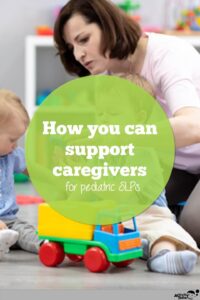
Guilt from risk factors (genetic or environmental)
One of the first tasks when a caregiver arrives at a doctor or other health professional’s office is filling out a medical history form. While we might view this information as neutral or a clue to what type of delay/disorder a child might have, for a parent it can feel like we’re seeking a cause or blame. This is particularly common for speech and language disorders that run in families like dyslexia, apraxia, or stuttering.
Other medical history characteristics like maternal/paternal age, complications during pregnancy or birth may leave a parent feeling like they could have done more or a sense of responsibility for their child’s deficits.
Guilt from parenting styles/decisions
Speech-language pathologists often have a few quick tips for families of “late talkers” and other language delays – establish a reading habit, decrease screen use, create motivating environments for requests. For many caregivers, these tips can feel like judgement on their parenting style or education.
It’s also common for caregivers to receive well-meaning advice from others such as “you have to stop doing everything for him” or “you baby him too much.”
How can we support caregivers with guilt?
Provide families with up-to-date information on disorders which may include risk factors. Present this information neutrally. Explain that having an understanding of other family members with similar difficulties can give us a better idea of what to expect.
Give caregivers time to adjust to new information and/or diagnosis. It often helps to provide written information along with verbal explanations.
Click here for Caregiver Education Handouts.
Use strengths-based language rather than focusing on weaknesses or deficits when describing current status or characteristics. For instance, you might say “child shows a strong preference for playing with vehicles” rather than “child is unable to play with a range of toys or types of toys.”
Focus on the tasks at hand. Giving caregivers manageable tasks to work on at home let’s them know they are an integral part of their child’s success! It’s empowering to have a better understanding of their child’s struggles and how to help.
Adopt a family centered approach to treatment. Show caregivers you understand the unique challenges they face by taking an active interest in their day-to-day routines. Rather than assigning home activities based on what you’re doing in the therapy room, brainstorm ideas that include favorite activities/routines at home.
Let them know they aren’t alone. Share resources in your area or online that offer caregiver communities especially those focused on caregivers navigating similar experiences.
You may also be interested in sharing these blog posts:
- Introduction to Apraxia
- Introduction to Stuttering (coming soon!)
- Introduction to AAC
- Understanding Neurodiversity
- Understanding IEPs/IFSPs







